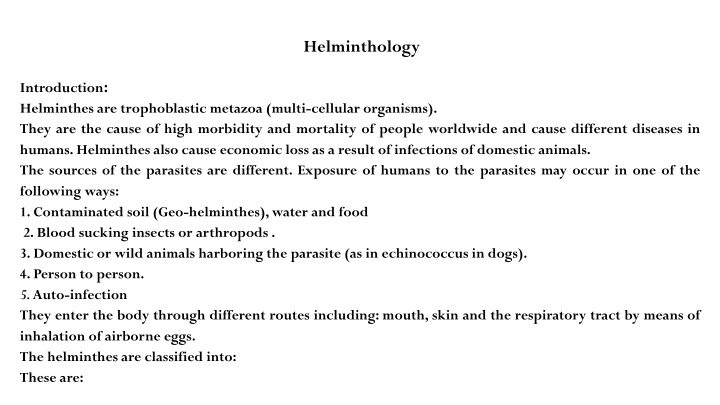
Helminthology: A Detailed Overview of Tapeworm Infections
Helminths, including tapeworms, are significant parasites causing morbidity worldwide. This piece delves into the characteristics, life cycle, and infection mechanisms of Echinococcus granulosus, a tapeworm responsible for echinococcosis. Understand the morphology, transmission routes, and life cycle stages of this parasite to enhance awareness and prevention strategies.
Download Presentation

Please find below an Image/Link to download the presentation.
The content on the website is provided AS IS for your information and personal use only. It may not be sold, licensed, or shared on other websites without obtaining consent from the author. If you encounter any issues during the download, it is possible that the publisher has removed the file from their server.
You are allowed to download the files provided on this website for personal or commercial use, subject to the condition that they are used lawfully. All files are the property of their respective owners.
The content on the website is provided AS IS for your information and personal use only. It may not be sold, licensed, or shared on other websites without obtaining consent from the author.
E N D
Presentation Transcript
Helminthology Introduction: Helminthes are trophoblastic metazoa (multi-cellular organisms). They are the cause of high morbidity and mortality of people worldwide and cause different diseases in humans. Helminthes also cause economic loss as a result of infections of domestic animals. The sources of the parasites are different. Exposure of humans to the parasites may occur in one of the following ways: 1. Contaminated soil (Geo-helminthes), water and food 2. Blood sucking insects or arthropods . 3. Domestic or wild animals harboring the parasite (as in echinococcus in dogs). 4. Person to person. 5. Auto-infection They enter the body through different routes including: mouth, skin and the respiratory tract by means of inhalation of airborne eggs. The helminthes are classified into: These are:
A-Phylum Platyhelminthes (flat worms) Class Nematodes (Round worms) B-Phylum Nemathelminthes: Class :Trematodes (Flukes) Class :Cestodes (Tape worms) Class: Cestodes (Tapeworms) Introduction 1-The tape worms are hermaphroditic and require an intermediate host. 2- The adult tapeworms found in humans have flat body, white or grayish in color. 3- They consist of an anterior attachment organ or scolex and a chain of segments (proglottids) also called strobilla. 4-The strobilla is the entire body except the scolex. 5- The scolex has suckers or grooves. It has rosetellum, which has 1 or 2 rows of hooks situated on the center of the scolex. Adult tapeworms inhabit the small intestine, where they live attached to the mucosa. 6-Tapeworms do not have a digestive system. Their food is absorbed from the host s intestine.
Family: Taeniidae Echinococcus granulosus There are two different species. These are: Echinococcus granulosus and Echinococcus multilocularis Echinococcus granulosus (dog tape worm) Responsible for most cases of echinococcosis. Echinococcosis is caused by larval tapeworms. Morphology The adult worm measures 3-6 mm in length (up to 1 cm). It has scolex, neck and strobilla. Adult worms live in small intestine of definitive host (dog). Man is an intermediate host - carrying the hydatid cyst (larva). Man contracts infection by swallowing eggs in excreta of definitive host.
Description: Description: Echinococcus granulosus picture Description: Description: Echinococcus granulosus picture
Life cycle The adult Echinococcus granulosus (3 to 6 mm long) 1. Resides in the small bowel of the definitive hosts, dogs or other canids. 2. Gravid proglottids release eggs that are passed in the feces. 3. After ingestion by a suitable intermediate host (under natural conditions: sheep, goat, swine, cattle, horses, camel), the egg hatches in the small bowel and releases an oncosphere 4. Oncosphere penetrates the intestinal wall and migrates through the circulatory system into various organs, especially the liver and lungs. 5. In these organs, the oncosphere develops into a cyst that enlarges gradually, producing protoscolices and daughter cysts that fill the cyst interior. 6. The definitive host becomes infected by ingesting the cyst-containing organs of the infected intermediate host. 7. After ingestion, the protoscolices evaginate, attach to the intestinal mucosa, and develop into adult stages in 32 to 80 days.
Pathogenecity Oncosphere hatch in duodenum or small intestine into embryos (oncosphere) which: Penetrate wall Enter portal veins Migrate via portal blood supply to organs: eg: lungs, liver, brain etc., thus, causing extra intestinal infections. In these organs, larvae develop into hydatid cysts. The cysts may be large, filled with clear fluid and contain characteristic protoscolices (immature forms of the head of the parasite). These mature into developed scolices, which are infective for dogs. Mode of human infection Ingestion of eggs by the following ways: i) Ingestion of water or vegetables polluted by infected dog feces. ii) Handling or caressing infected dogs where the hairs are usually contaminated with eggs.
Clinical features Asymptomatic infection is common, but in symptomatic patients It may cause cough - with hemoptysis in lung hydatid disease. Hepatomegaly - with abdominal pain and discomfort Pressure -from expanding cyst Rupture of cyst - severe allergic reaction - anaphylaxis. Diagnosis X-ray or other body scans Demonstration of protoscolices in cyst after operation Serology















